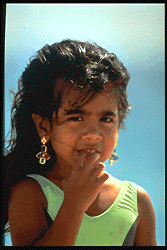
 Before Columbus arrived here during his second voyage in 1493,
the island had already been inhabited for some one thousand
years. The first people to settle here were a tribe of Arawak
Indians who left their homeland in the Orinoco basin of South
America and kept migrating upwards along the chain of islands in
the Caribbean. They gave it the name "Sualouiga" meaning "Land
of Salt" for the salt-pans and the brackish water they found
here in great abundance. The few fresh water springs around Paradise Peak, Mount William, Billy Folly, and in the Lowlands could only support a small population, and this is where they
mainly tended to congregate. A number of artifacts from this
period are to be found preserved in the St.Martin Museum: On the Trail of the Arawaks. The Arawaks were later supplanted by
a more aggressive tribe of Indians, the Caribs, who came down
from North America and for whom the entire Caribbean is named. Before Columbus arrived here during his second voyage in 1493,
the island had already been inhabited for some one thousand
years. The first people to settle here were a tribe of Arawak
Indians who left their homeland in the Orinoco basin of South
America and kept migrating upwards along the chain of islands in
the Caribbean. They gave it the name "Sualouiga" meaning "Land
of Salt" for the salt-pans and the brackish water they found
here in great abundance. The few fresh water springs around Paradise Peak, Mount William, Billy Folly, and in the Lowlands could only support a small population, and this is where they
mainly tended to congregate. A number of artifacts from this
period are to be found preserved in the St.Martin Museum: On the Trail of the Arawaks. The Arawaks were later supplanted by
a more aggressive tribe of Indians, the Caribs, who came down
from North America and for whom the entire Caribbean is named.Columbus never actually set foot on the island, but rather laid claim to it for Spain as he was passing by. The first time he caught sight of land here was on the 11th of November, 1493, the feast of St.Martin, the medieval archbishop of Tours, and that is how the island acquired its present name. The Spanish, aside from asserting title to the place, never took much interest in St.Martin, so the Dutch, seeking an outpost halfway between their colonies in Pernambuco in Brazil and Nieue Amsterdam (now New York), began to occupy the island in 1631. The Dutch West India Company installed Jan Claeszen van Campen as governor, erected their first fort on the site of Fort Amsterdam, and began to mine for salt. Before long, however, the Spanish, who wished to preserve their state monopoly in this essential ingredient for preserving food, became aware of the incursion into their territory, and in 1633 they recaptured the island, expelling all of the Dutch who then moved on to occupy Curacao. Over the next fifteen years, a number of abortive attempts were made by the Dutch to reclaim their lost possession, notably an assault led by Peter Stuyvesant in 1644 in which the future governor of Nieue Amsterdam lost his leg. The Spanish Commander, who was regularly besieged during this period, asked permission after his last victory to abandon the island, and in 1647 this right was finally conceded to him by the King of Spain. Laborers were brought in from Puerto Rico to dismantle the fortress, and the Spanish set sail, leaving behind, according to legend, a small contingent of French and Dutch who hid on the island and then sent out to neighboring colonies for reinforcements. How the Dutch and French finally partitioned the island between them now makes for a great story. Supposedly, the two groups entered into a contest between them. Starting at Oysterpond on the east coast, they would walk westwards -- the French along the northern edge, the Dutch along the southern -- and where they met they would draw a line across dividing up the land. The French set off having fortified themselves with wine, the Dutch with gin. The ill effects of the gin, however, caused the Dutchmen to stop along the way to sleep off their drunk, and the French were able to cover a much greater distance. In truth, though, the French had a large navy just off shore at the time the treaty was being negotiated, and they were able to win concessions by threat of force. The treaty was signed on top of Mount Concordia in 1648, but despite the reputation for peaceful cohabitation, the border was to change another sixteen times until 1815 when the Treaty of Paris fixed the boundaries for good. The cultivation of sugar cane introduced slavery onto the island, and hundreds of African men, women, and children were imported for this purpose. The French finally abolished slavery in 1848 on the date that is celebrated as Schoelcher Day, July 21. The Dutch slaves were emancipated fifteen years later. Following the end of slavery, the island entered a serious depression that was to last until 1939 when the island was declared a duty-free port. The Dutch began developing a tourist industry in the 1950's, but the French were not to take advantage of this opportunity until the 1970's. St.Martin continued its large-scale construction projects throughout the 1980's, but now most building has been completed, and great care has been taken to preserve the island's natural resources. Today, St.Martin belongs to the prefecture of Guadeloupe and is considered to be just another part of France. Islanders are entitled to vote in French elections.
|
| St. Martin Home Page | History & Culture | Points of Interest | Activities | Travel Tips | Transportation | Accommodations | Restaurants & Nightlife | Calendar of Events | Best Bets | Tourist Offices | The St. Martin Browser's Page | InterKnowledge Home |
Copyright (c) 1995-2000 interKnowledge Corp. All rights reserved.